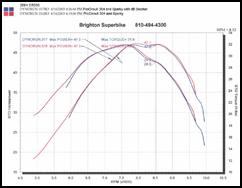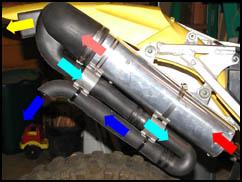|
|||||||||||||||||||||||||||||||||
As the
dirt bike editor for off-road.com for going on 7 years, you would think
that I would wallow in a stack of products to test and have one or two new
bikes to test each year. The reality of the situation is that I end up
doing more editorly things, and the vast majority of my seat time is spent
in front of a computer rather than in the saddle of my aging but trusty
As many of our readers are aware, noise pollution from performance dirt bikes and ATV's on public lands and tracks are a rising concern amongst landowners and other non-mechanized recreationalists, and is increasingly becoming an issue cited when determining management plans for the future. Tracks and other facilities that were once well outside of populated areas are now being encroached upon by expanding developments that are now collectively deciding that they no longer want these noisy neighbors. Thus, the development of quiet series pipes has taken off with a (quiet) bang. While the last few years have really brought about some significant advances in quiet pipe technology, the focus (with some exceptions) has always been on what is currently popular or widely used. With the explosion in affordable and lightweight high performance four-stroke machines, there isn't as much benefit in development of quiet performance two-stroke pipes as in recent years. The losers in this struggle are folks who have older or less popular bikes, and ultimately everyone. If there isn't a quiet pipe available, there's no way to do the responsible thing. As many pro-access OHV groups have stated over the last 25 years, Less Sound = More Ground.
Enter the dB Snorkel - this rather unique exhaust system add-on claims it can reduce
For example, an '04 CR250 was tested by dB Snorkel with both the FMF TurbineCore 2 (91 dB in the 20" SAE J1287 test) and the ProCircuit 304 & Sparky (96 dB in the 20" SAE J1287 test); the addition of the dB Snorkel scrubs 3 dB off the quiet FMF, and 6 dB off the performance ProCircuit. This is pretty impressive stuff, especially considering the results of their dyna-mometer testing with and without the dB Snorkel. As is so often the case, the inspiration for this product originally came from personal need. In 2000 when dB Snorkel founder and CCC member Sydney Gearing attempted to participate in the Cycle Conservation Club of Michigan's annual "Rights of Spring" ride, he failed to pass the Michigan 94 dB(A) limit sound check with his US Forest Service Approved spark arrestor/silencer. While the spark arrestor clearly satisfied the federal limit of 99 dB (A) at that time, the silencer simply wasn't going to cut it in his home state; faced with the choice of either a more mild-mannered machine than his current CR 500, or a more restrictive pipe – he chose a third option. Syd Gearing on the dB Snorkel:
The system works by routing exhaust noise and gasses from the end of the silencer Peak pressure from the exhaust pulse is released from a smaller opening (photo right) in the base of the dB Snorkel, which, like the primary path, is directed toward the ground. This has the advantages of reducing the overall backpressure of the additional length of the exhaust path, directing the sound towards the ground where more of it can be absorbed, and releasing two out-of-phase exhaust pulses rather than a single larger exhaust pulse.
I have to say that my initial impression of the dB Snorkel was extremely positive. While dB Snorkel may be a small company, they are obviously very detail-oriented and put in some serious R&D time on this product. The design of the Snorkel itself is appealing to the engineer in me - the twin exhaust ports, the flexible sound absorbing material, and the straightforward no nonsense design? Well OK – it does look a bit funny, but it grew on me. The packaging and components all looked to be of a very high quality. Probably the most impressive item included was the installation instructions. This was no simple photocopied half-page of text instructions, but a professionally printed poster-size page of obviously well considered instructions and extremely useful illustrations. Impressive also is that the pre-production product testing was taken extremely seriously. During the testing period of this product, Syd was extremely responsive, shipping out re-thought parts based on comments and their own testing. The releasable zip ties were updated with a more secure permanent zip tie, a change which really doesn't affect temporary removal of the dB Snorkel, but does reduce the possibility of the L-Tube coming loose on its own. Black oxide coated band clamps were substituted for several of the stainless clamps so that they would be less visible against the body of the snorkel.
Installation of the dB Snorkel was a fairly simple process with only a few tools required – whatever you need to remove your side panel from your bike, a phillips screwdriver, a sharp utility blade, and a measuring tape. I say simple providing your silencer has a welded or carefully milled mounting bracket. As with many aluminum-bodied silencers, the FMF TurbineCore II installed on my RM250 has a rib that is extruded with the body and runs the length of the silencer and from which the mount holes are machined. Anyone familiar with mounting an add-on spark arrestor should immediately see the problem: the last inch or so of this rib needs to be filed off to achieve any kind of decent seal. I elected to take the path of least resistance and use power tools, but anyone not already familiar with power tools and aluminum should probably follow the instructions and use a good quality mill file to remove the majority of the rib, and a very fine file for the final cleanup. With power tools, it is far easier to take off material than to put it back. I chose to use an angle grinder with an extremely thin cutting disc to remove the majority of the rib, and then went back over it with a very fine sanding disc to remove some rough edges. Final smoothing and shaping was accomplished with extremely fine flat and round files. I chose to buff out the remaining tool marks on the silencer with a Dremel buffing wheel.
The remainder of the install is not tough or incredibly time consuming, but it wasn't a total piece of cake. There are a number of products out there that I have personally had to modify to fit - and some that fit so poorly I sent the product back. The dB Snorkel it fit and installed as promised. However I highly recommend a careful first reading of the instructions; there are a number of details that can slip by once you have tools in your hands. For the purposes of this review, all of the photos were taken with the silencer removed from the bike, but it is critical to perform the trial fitting with it mounted to the bike, and it's easier as well.
Careful attention needs to be paid to locating the Large Band Clamps and Mounting Halves. I personally had to do a fair amount of fiddling to get things just so, but once the initial fitting has been completed, the dB Snorkel can be removed and reinstalled fairly easily by releasing the large band clamps.
Let me state from the outset that I am no acoustical engineer and that I posses no special skills, tools or testing equipment. Once the dB Snorkel was installed, I wanted a way to quantitatively/objectively evaluate the effect of the snorkel had over my stock TurbineCore II silencer/spark arrestor without dropping cash for a high quality dB tester, or inviting a ticket from the city Noise Ordinance Officer by asking for this favor. Unfortunately, I was not able to produce an eaisily quantifiable result under the circumstances, although I will try again soon. Check back! Testing Equipment
Location & Conditions Since sound radiates out in all directions from a source of noise, an enclosed space or a space with hard surfaces that could reflect sound were poor choices for this testing. Ideally, the perfect place would be exactly where you would ride a dirtbike, out in the open. Due to the fact that it was pouring rain, the test site had to be sheltered and ended up being in a grassy section of my yard with structures nearby. Oh well! The microphone was located about 15 feet directly behind the motorcycle just under the porch roof. Because I was not using a directional microphone, and sound from the engine and expansion chamber was bouncing back from my house and garage I was unable to properly isolate the only normal source of focused sound - the exhaust. The silencer has not recently been repacked since it is nearly new, I probably have about 15 hours on the current packing – FMF recommends repacking after 10 hours. The temperature was in the middle 50's with 100% humidity - dense air, also not ideal.
Despite my difficulties obtaining clear proof, the test still yielded some interesting results:
Other Observations:
While it was difficult to quantify the results, my personal perception was that it helped. As my wife said, it "took the edge off" the higher frequencies, and that is the difference between just being loud and making you jump out of your skin. Further testing under more controlled conditions would be necessary to give objective results. The following are changes I would make when I do this again:
This is a thoughtfully designed, well-made product, and it is unique in the market at this time. The question: "Is it worth $85?" is one I am not really ready to ask, but if you are a conscientious, performance oriented individual the answer is pretty clear. I feel that it made a difference on my bike and I plan on using it.
|
Follow @Off-Road








 Your Privacy Choices
Your Privacy Choices